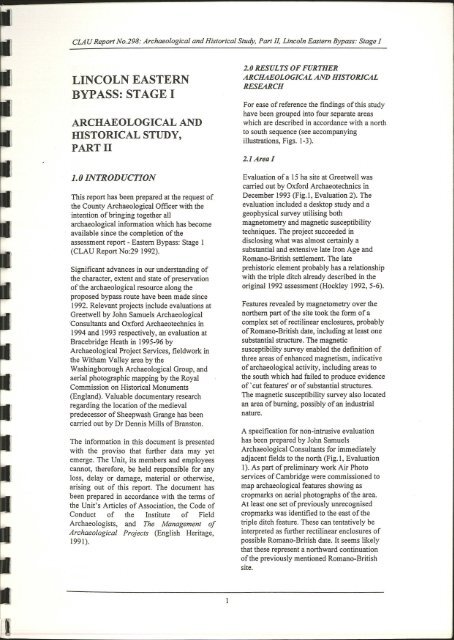lincoln eastern bypass: stage i - Archaeology Data Service
lincoln eastern bypass: stage i - Archaeology Data Service
lincoln eastern bypass: stage i - Archaeology Data Service
You also want an ePaper? Increase the reach of your titles
YUMPU automatically turns print PDFs into web optimized ePapers that Google loves.
CLAU Report No.298: Archaeological and Historical Study, Part II, Lincoln Eastern Bypass: Stage I<br />
LINCOLN EASTERN<br />
BYPASS: STAGE I<br />
ARCHAEOLOGICAL AND<br />
HISTORICAL STUDY,<br />
PART II<br />
1.0 INTRODUCTION<br />
This report has been prepared at the request of<br />
the County Archaeological Officer with the<br />
intention of bringing together all<br />
archaeological information which has become<br />
available since the completion of the<br />
assessment report - Eastern Bypass: Stage 1<br />
(CLAU Report No:29 1992).<br />
Significant advances in our understanding of<br />
the character, extent and state of preservation<br />
of the archaeological resource along the<br />
proposed <strong>bypass</strong> route have been made since<br />
1992. Relevant projects include evaluations at<br />
Greetwell by John Samuels Archaeological<br />
Consultants and Oxford Archaeotechnics in<br />
1994 and 1993 respectively, an evaluation at<br />
Bracebridge Heath in 1995-96 by<br />
Archaeological Project <strong>Service</strong>s, fieldwork in<br />
the Witham Valley area by the<br />
Washingborough Archaeological Group, and<br />
aerial photographic mapping by the Royal<br />
Commission on Historical Monuments<br />
(England). Valuable documentary research<br />
regarding the location of the medieval<br />
predecessor of Sheepwash Grange has been<br />
carried out by Dr Dennis Mills of Branston.<br />
The information in this document is presented<br />
with the proviso that further data may yet<br />
emerge. The Unit, its members and employees<br />
cannot, therefore, be held responsible for any<br />
loss, delay or damage, material or otherwise,<br />
arising out of this report. The document has<br />
been prepared in accordance with the terms of<br />
the Unit's Articles of Association, the Code of<br />
Conduct of the Institute of Field<br />
Archaeologists, and The Management of<br />
Archaeological Projects (English Heritage,<br />
1991).<br />
1<br />
2.0 RESUL TS OF FURTHER<br />
ARCHAEOLOGICAL AND HISTORICAL<br />
RESEARCH<br />
For ease of reference the findings of this study<br />
have been grouped into four separate areas<br />
which are described in accordance with a north<br />
to south sequence (see accompanying<br />
illustrations, Figs. 1-3).<br />
2.1 Area I<br />
Evaluation of a 15 ha site at Greetwell was<br />
carried out by Oxford Archaeotechnics in<br />
December 1993 (Fig.l, Evaluation 2). The<br />
evaluation included a desktop study and a<br />
geophysical survey utilising both<br />
magnetometry and magnetic susceptibility<br />
techniques. The project succeeded in<br />
disclosing what was almost certainly a<br />
substantial and extensive late Iron Age and<br />
Romano-British settlement. The late<br />
prehistoric element probably has a relationship<br />
with the triple ditch already described in the<br />
original 1992 assessment (Hockley 1992, 5-6).<br />
Features revealed by magnetometry over the<br />
northern part of the site took the form of a<br />
complex set of rectilinear enclosures, probably<br />
of Romano-British date, including at least one<br />
substantial structure. The magnetic<br />
susceptibility survey enabled the definition of<br />
three areas of enhanced magnetism, indicative<br />
of archaeological activity, including areas to<br />
the south which had failed to produce evidence<br />
of'cut features' or of substantial structures.<br />
The magnetic susceptibility survey also located<br />
an area of burning, possibly of an industrial<br />
nature.<br />
A specification for non-intrusive evaluation<br />
has been prepared by John Samuels<br />
Archaeological Consultants for immediately<br />
adjacent fields to the north (Fig.l, Evaluation<br />
1). As part of preliminary work Air Photo<br />
services of Cambridge were commissioned to<br />
map archaeological features showing as<br />
cropmarks on aerial photographs of the area.<br />
At least one set of previously unrecognised<br />
cropmarks was identified to the east of the<br />
triple ditch feature. These can tentatively be<br />
interpreted as further rectilinear enclosures of<br />
possible Romano-British date. It seems likely<br />
that these represent a northward continuation<br />
of the previously mentioned Romano-British<br />
site.

















